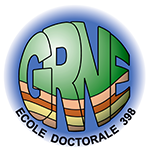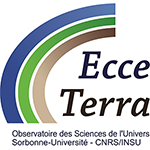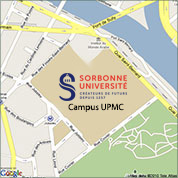Cubas Nadaya

Equipe : Tectonique
Maître de conférences
Sorbonne Université - Campus Pierre et Marie Curie, Tour 46 - 00 2ème étage, Bureau 210
Téléphone : 33 1 44 27 45 90
E-mail : nadaya.cubas@sorbonne-universite.fr
Thèmes de recherche
Sismo-tectonique, mécanique des failles - Relations entre déformations court-terme (échelle du cycle sismique) et long-terme (construction de prismes). Modélisation mécanique, analytique, numérique, analogique, statique ou dynamique, selon le problème étudié.
Bibliographie
S. Visage, Souloumiac P., N. Cubas, Maillot B., Antoine S., Delorme A. and Klinger Y. (2023), Evolution of o -fault deformation of strike-slip fault in a sand-box experiment, Tectonophysics, https ://doi.org/10.1016/j.tecto.2023.229704.
Pajang S., M. Mahdi Khatib, M. Heyhat, N. Cubas, E. Bessiere, J. Letouzey, M. Mokhtari, L. Le Pourhiet (2022), The distinct morphologic signature of underplating and seamounts in accretionary prisms, insights from thermomechanical modeling applied to Coastal Iranian Makran, Tectonophysics, https://doi.org/10.1016/j.tecto.2022.229617.
Cubas, N., Agard, P., and Tissandier, R., (2022), Earthquake ruptures and topography of the Chilean margin controlled by plate interface deformation, Solid Earth, https://doi.org/10.5194/se-2021-148.
Ahmed A., et al (2022), Across and along-strike crustal structure variations of the western Afar margin and adjacent plateau: Insights from receiver functions analysis, Journal of African Earth Sciences, https://doi.org/10.1016/j.jafrearsci.2022.104570.
Pajang, S., Le Pourhiet, L., and Cubas, N. (2022), The topographic signature of temperature-controlled rheological transitions in an accretionary prism, Solid Earth, 13, 535–551, doi:10.5194/se-13-535-2022, 2022.
C. Herviou, P. Agard, A. Plunder, K. Mendes, A. Verlaguet, D. Deldicque, N. Cubas (2022), Subducted fragments of the Liguro-Piemont ocean, Western Alps: Spatial correlations and offscraping mechanisms during subduction, Tectonophysics, doi.org/10.1016/j.tecto.2022.229267
S. Pajang, N. Cubas, Jean Letouzey, L. Le Pourhiet, S. Seyedali, P. Agard, M. M. Khatib, M. Heyhat, M. Mokhtari (2021), Seismic hazard of the Western Makran subduction zone : insight from mechanical modelling and inferred frictional properties, Earth and Planetary Science Letters, doi :10.1016/j.epsl.2021.116789.
J. Goncalves de Souza, N. Cubas, C. Rabe, J. Letouzey, R. Divies, D. B. Praeg, D. Granjeon, A. Machado Cruz, C. Guizan Silva, A. Tadeu dos Reis, C. Gorini (2020), Controls on overpressure evolution during the gravitational collapse of the Amazon deep-sea fan, Marine and Petroleum Geology, doi :10.1016/j.marpetgeo.2020.104576.
L. Jeandet, N. Cubas, H. Bhat, P. Steer (2020), The Impact of Large Erosional Events and Transient Normal Stress Changes on the Seismicity of Faults, Geophysical Research Letters, doi :10.1029/2020GL087631.
M. Lefevre, P. Souloumiac, N. Cubas, Y. Klinger (2020), Experimental evidence for crustal control over seismic fault segmentation, Geology, doi :10.1130/G47115.1.
P. Steer, L. Jeandet, N. Cubas et al. (2020), Earthquake statistics changed by typhoon-driven erosion, Scientific Report, doi :10.1038/s41598-020-67865-y
Rolandone et al. (2018), Areas prone to slow slip events impede earthquake rupture propagation and promote afterslip, Science Advances, doi :10.1126/sciadv.aao6596.
N. Cubas, P. Souloumiac, S. Singh (2016), Relationship link between landward vergence in accretionary prisms and tsunami generation, Geology, doi :10.1130/G38019.1.
B. Rousset, C. Lasserre, N. Cubas, et al. (2016), Lateral Variations of Interplate Coupling along the Mexican Subduction Interface : Relationships with Long-Term Morphology and Fault Zone Mechanical Properties, Pure and Applied Geophysics, doi :10.1007/s00024-015-1215-6.
A. K. Kuncoro, N. Cubas, S. C. Singh, M. Etchebes, P. Tapponnier (2015), Tsunamigenic potential due to frontal rupturing in the Sumatra locked zone, Earth and Planetary Science Letters, 432, p.311-322, doi :10.1016/j.epsl.2013.07.037.
N. Cubas, N. Lapusta, J. P. Avouac, H. Perfettini (2015), Numerical modeling of long-term earthquake sequences on the NE Japan megathrust : Comparison with observations and implications for fault friction, Earth and Planetary Science Letters, 419, p.187-198, doi :10.1016/j.epsl.2015.03.002.
N. Cubas, J. P. Avouac, P. Souloumiac, Y. Leroy (2013)c, Megathrust friction determined from mechanical analysis of the forearc in the Maule Earthquake area, Earth and Planetary Science Letters, 381,p.92- 103, doi :10.1016/j.epsl.2013.07.037.
N. Cubas, J. P. Avouac, Y. Leroy, A. Pons (2013)b, Low friction along the high slip patch of the 2011 Mw 9.0 Tohoku-Oki earthquake required from the wedge structure and extensional splay faults, Geophysical Research Letters, 40, p.4231-4237, doi :10.1002/grl.50682.
N. Cubas, C. Barnes, B. Maillot (2013)a, Inverse method applied to a sand wedge : estimation of friction pa- rameters and uncertainty analysis, Journal of Structural Geology, 55, p.101-113, doi :10.1016/j.jsg.2013.07.00
Z. Zhan, D. Helmberger, M. Simons, H. Kanamori, W. Wub, N. Cubas, Z. Duputel, R. Chu, V. C. Tsai, J.-P. Avouac, K. W. Hudnut, S. Ni, E. Hetland, F. H Ortega Culaciati (2012), Anomalously steep dips of earthquakes in the 2011 Tohoku-Oki source region and possible explanations, Earth and Planetary Science Letters, 353-354, p.121-133, doi :10.1016/j.epsl.2012.07.038.
N. Cubas, B. Maillot, C. Barnes (2010), Statistics of the experimental growth of a sand wedge, Journal of Structural Geology, 32, p.818-831, doi :10.1016/j.jsg.2010.05.010.
N. Cubas, Y.M. Leroy, B. Maillot, C. Barnes, M. Pubellier (2009), Prediction of thrusting sequence based on maximum rock strength and sandbox validation, Trabajos de Geologia, 28.
N. Cubas, Y.M. Leroy, B. Maillot (2008), Prediction of thrusting sequences in accretionary wedges, Journal of Geophysical Research, B12412, 21 pages, doi : 10.1029/2008JB005717.
Enseignements
- L1 PEIP, Terre-Climat-Environnement
- L2, Stage de Terrain 2, Barles
- L3 ST, Géodynamique
- M1 StePe, Géomorphologie
- M1 SDUE, Grandes Questions Environnementales
- M2, Mécanique de la lithosphère
- M2, Fluides, roches, déformations
- Préparation Agrégation, Leçons
Responsabilités
2022-2026: Conseil du département de la Licence Sciences de la Terre
2016-2025: Conseil UMR
Co-Responsable des séminaires de l’ISTEP
Co-Responsable de l’axe Aléas Naturels.
2015-2018: Responsable pédagogique L3 Sciences de la Terre
Projets
- ANR JCJC MechaThrust (2023-2026), Towards a MECHAnical understanding of megaTHRUST behavior, PI: Nadaya Cubas.
- ANR ALBANEO (2023-2027), Active fault systems at an incipient plate boundary in the Alboran Sea, PI: E. d’Acremont (ISTeP). Partenaire (Mechanical and kinematic modelling of the strike-slip fault systems).
- ANR FLUID2SLIP (2021-2025), Lithospheric Fluid circulation in subduction system: impact on slip mode, PI : Audrey Galve (Geoazur). Responsable Task 5: Modelling processes to derive key parameters controlling slip behaviour.
- ANR DISRUPT (2018-2022), Deformation and Earthquake Surface Ruptures : from Observation to Processes, PI : Yann Klinger (IPGP). Partenaire WP3 (modélisation analogique).
- ANR SEAFFRONTERA (2013-2015-7): SEAmount and FRONTal megathrust Tsunami and Earthquake Risk Assessment of the last seismic gap of Sumatra subduction zone, PI: Nadaya Cubas (IPGP-ISteP).
Parcours
- 2023 : Habilitation à Diriger des Recherches, SU, Paris, France.
- Depuis 2014: Maître de Conférences ISTeP, SU, Paris, France
- 2013-2014: Postdoc (ANR retour postdoc) IPGP, Geosciences Marines, Paris, France
- 2009-2013: Postdoc Caltech, Tectonics Observatory, Pasadena, USA
- 2005-2009: Thèse, Laboratoire Géologie, ENS, Paris, Fr.
Egalement dans la rubrique
Chiffres clés (Mars 2025)
L'ISTeP comprend 131 membres dont :
Permanents (66)
- Professeurs : 17 (+2 PAST)
- Maîtres de conférence : 26
- Directeurs de recherche CNRS : 1
- Chargés de recherche CNRS : 1
- ITA : 19
Personnels non permanents (65)
- Collaborateurs bénévoles / émérites : 17
- Chaire de professeur junior : 1
- Enseignants-chercheurs contractuel : 2
- 1 MCF accueil en délégation
- ATER et Post-Docs : 9
- Doctorants : 32
- ITA-BIATSS : 3





